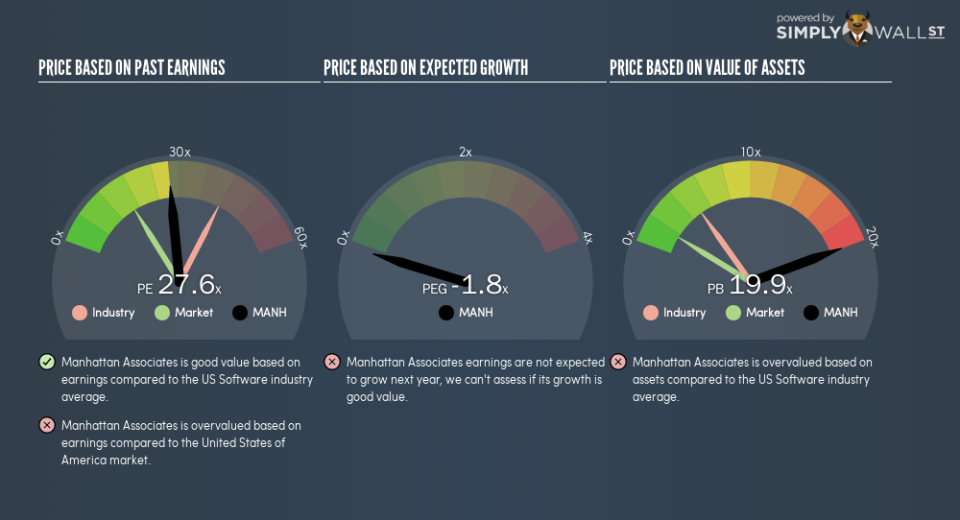Do You Know What Manhattan Associates, Inc.’s (NASDAQ:MANH) P/E Ratio Means?

This article is for investors who would like to improve their understanding of price to earnings ratios (P/E ratios). We’ll show how you can use Manhattan Associates, Inc.’s (NASDAQ:MANH) P/E ratio to inform your assessment of the investment opportunity. Manhattan Associates has a price to earnings ratio of 27.65, based on the last twelve months. That corresponds to an earnings yield of approximately 3.6%.
View our latest analysis for Manhattan Associates
How Do I Calculate A Price To Earnings Ratio?
The formula for P/E is:
Price to Earnings Ratio = Price per Share ÷ Earnings per Share (EPS)
Or for Manhattan Associates:
P/E of 27.65 = $42.6 ÷ $1.54 (Based on the trailing twelve months to September 2018.)
Is A High P/E Ratio Good?
A higher P/E ratio means that buyers have to pay a higher price for each $1 the company has earned over the last year. That isn’t necessarily good or bad, but a high P/E implies relatively high expectations of what a company can achieve in the future.
How Growth Rates Impact P/E Ratios
Earnings growth rates have a big influence on P/E ratios. When earnings grow, the ‘E’ increases, over time. That means even if the current P/E is high, it will reduce over time if the share price stays flat. A lower P/E should indicate the stock is cheap relative to others — and that may attract buyers.
Manhattan Associates shrunk earnings per share by 12% over the last year. But it has grown its earnings per share by 14% per year over the last five years.
How Does Manhattan Associates’s P/E Ratio Compare To Its Peers?
We can get an indication of market expectations by looking at the P/E ratio. If you look at the image below, you can see Manhattan Associates has a lower P/E than the average (41.7) in the software industry classification.
This suggests that market participants think Manhattan Associates will underperform other companies in its industry. While current expectations are low, the stock could be undervalued if the situation is better than the market assumes. You should delve deeper. I like to check if company insiders have been buying or selling.
A Limitation: P/E Ratios Ignore Debt and Cash In The Bank
The ‘Price’ in P/E reflects the market capitalization of the company. That means it doesn’t take debt or cash into account. Hypothetically, a company could reduce its future P/E ratio by spending its cash (or taking on debt) to achieve higher earnings.
Such expenditure might be good or bad, in the long term, but the point here is that the balance sheet is not reflected by this ratio.
Manhattan Associates’s Balance Sheet
The extra options and safety that comes with Manhattan Associates’s US$94m net cash position means that it deserves a higher P/E than it would if it had a lot of net debt.
The Verdict On Manhattan Associates’s P/E Ratio
Manhattan Associates trades on a P/E ratio of 27.6, which is above the US market average of 16.4. The recent drop in earnings per share would make some investors cautious, but the relatively strong balance sheet will allow the company time to invest in growth. Clearly, the high P/E indicates shareholders think it will!
When the market is wrong about a stock, it gives savvy investors an opportunity. People often underestimate remarkable growth — so investors can make money when fast growth is not fully appreciated. So this free visual report on analyst forecasts could hold they key to an excellent investment decision.
Of course you might be able to find a better stock than Manhattan Associates. So you may wish to see this free collection of other companies that have grown earnings strongly.
To help readers see past the short term volatility of the financial market, we aim to bring you a long-term focused research analysis purely driven by fundamental data. Note that our analysis does not factor in the latest price-sensitive company announcements.
The author is an independent contributor and at the time of publication had no position in the stocks mentioned. For errors that warrant correction please contact the editor at editorial-team@simplywallst.com.

